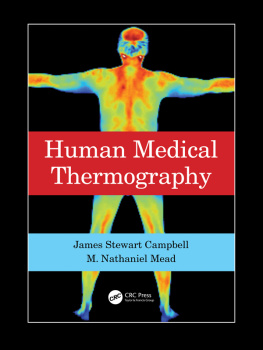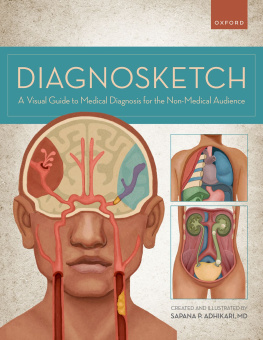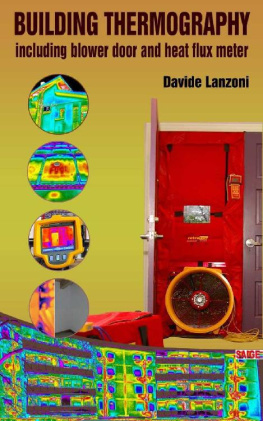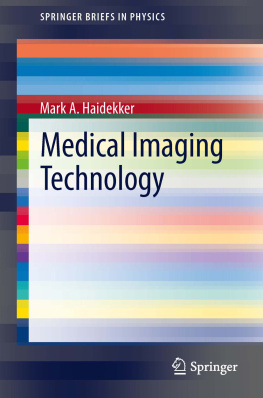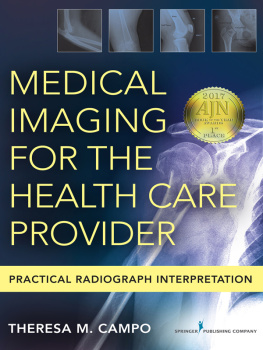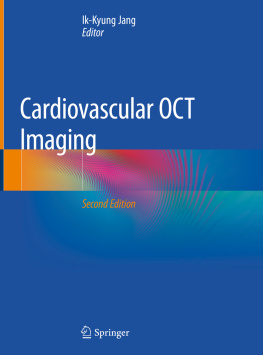CONTENTS
Tables
Figures

HUMAN MEDICAL THERMOGRAPHY
Want to incorporate medical infrared imaging into your practice but can't find a book that explains how to do it? Well, this book is for you! Complete, practical instructions are provided on imager choice and care as well as the physical needs of a thermography service from the imaging room layout to the computer requirements. How to acquire, interpret, and report a thermal examination is covered in detail. Fully illustrated with both normal and abnormal images, Human Medical Thermography provides practitioners of all types with the knowledge to design and operate a scientifically based thermography practice.
Key Features
Shows how to select the best thermal imager for your clinical practice, care for it, and use it correctly.
Explains how to take medical quality thermal images and scale them for maximum visual effect using the guidelines detailed in this book.
Details myriad ways that thermography can aid in medical diagnosis and improve surgical outcomes.
First edition published 2023
by CRC Press
6000 Broken Sound Parkway NW, Suite 300, Boca Raton, FL 33487-2742
and by CRC Press
4 Park Square, Milton Park, Abingdon, Oxon, OX14 4RN
CRC Press is an imprint of Taylor & Francis Group, LLC
2023 James Stewart Campbell and M. Nathaniel Mead
This book contains information obtained from authentic and highly regarded sources. While all reasonable efforts have been made to publish reliable data and information, neither the author[s] nor the publisher can accept any legal responsibility or liability for any errors or omissions that may be made. The publishers wish to make clear that any views or opinions expressed in this book by individual editors, authors or contributors are personal to them and do not necessarily reflect the views/opinions of the publishers. The information or guidance contained in this book is intended for use by medical, scientific or health-care professionals and is provided strictly as a supplement to the medical or other professional's own judgement, their knowledge of the patient's medical history, relevant manufacturer's instructions and the appropriate best practice guidelines. Because of the rapid advances in medical science, any information or advice on dosages, procedures or diagnoses should be independently verified. The reader is strongly urged to consult the relevant national drug formulary and the drug companies' and device or material manufacturers' printed instructions, and their websites, before administering or utilizing any of the drugs, devices or materials mentioned in this book. This book does not indicate whether a particular treatment is appropriate or suitable for a particular individual. Ultimately it is the sole responsibility of the medical professional to make his or her own professional judgements, so as to advise and treat patients appropriately. The authors and publishers have also attempted to trace the copyright holders of all material reproduced in this publication and apologize to copyright holders if permission to publish in this form has not been obtained. If any copyright material has not been acknowledged please write and let us know so we may rectify in any future reprint.
Except as permitted under U.S. Copyright Law, no part of this book may be reprinted, reproduced, transmitted, or utilized in any form by any electronic, mechanical, or other means, now known or hereafter invented, including photocopying, microfilming, and recording, or in any information storage or retrieval system, without written permission from the publishers.
For permission to photocopy or use material electronically from this work, access
Trademark notice: Product or corporate names may be trademarks or registered trademarks and are used only for identification and explanation without intent to infringe.
ISBN: 9781032251417 (hbk)
ISBN: 9781032251400 (pbk)
ISBN: 9781003281764 (ebk)
DOI: 10.1201/9781003281764
Typeset in Warnock Pro
by KnowledgeWorks Global Ltd.
Dedicated to Ms. Joyce B. Cary, President of Integrative Life Solutions, Inc., who facilitated the practice of medical thermography that made this book possible.
About the Authors
James Stewart Campbell, EE, MD. Interested in electronics from a young age, Dr. James Stewart Campbell received his bachelor's degree in Electrical Engineering from Lehigh University in 1966 and then went on to study medicine at the Albany Medical College in Albany, NY, receiving his MD degree in 1970. After completing a straight-surgical internship at the University of Washington, he helped found The Country Doctor Clinic in Seattle and practiced general medicine there until 1975.
In 1976, Dr. Campbell settled in Hayesville, North Carolina, where he founded the non-profit Mountain Peoples' Clinic and had a successful practice of general medicine. He also taught electronics at Tri-County Community College in Murphy, NC.
Dr. Campbell took a leave from clinical medicine in 1986 to work in biomedical engineering, specializing in biological-to-electronic interfacing. His design projects have included air plethysmography, non-invasive blood pressure devices, ultrasound imaging and flowmeters, photo-plethysmography, fluorescence microscopy, bio-impedance, bio-acoustics, intra-cardiac sensor-stimulators, and implantable neural probe systems.
In 2010, realizing that thermal signatures were clinically important to detect certain diseases, Dr. Campbell started a thermography service for Integrative Life Solutions, Inc., in Clemmons, NC. Over the next 7 years, the practice became a successful provider of general and breast thermography. After retiring from medical practice in 2017, he assembled the wealth of objective thermal data from the service into a large spreadsheet derived from over 1000 imaging sessions. These thermal images and numerical data, along with much additional research and writing by his co-author, form the foundation of this book.
Dr. Campbell lives in Pfafftown, North Carolina. He is a Life Senior Member of the Institute of Electrical and Electronics Engineers (IEEE) and a Senior Member of the American Academy of Thermology (AAT).
Mark Nathaniel Mead, MSc, earned his master's degree in Nutritional Epidemiology from the UNC Gillings School of Global Public Health. Through his work as a medical-scientific writer, he has over 40 scientific articles listed on PubMed, including papers published in the International Journal of Cancer, Journal of the National Cancer Institute, Integrative Cancer Therapies, Environmental Health Perspectives, and Cancer Treatment Reviews. In addition to 9 years as a contributing editor to Natural Health magazine, Mead served for 20 years as an editorial board member for Integrative Cancer Therapies (Sage Publications) and as a research associate for the Block Center for Integrative Cancer Treatment in Skokie, IL. He underwent clinical training in thermography under his co-author and has lectured at the annual scientific session of the American Academy of Thermology.
Introduction to Human Medical Thermography
DOI: 10.1201/9781003281764-1
The human body generates heat a byproduct of metabolism and must dissipate it to regulate internal body temperature. The majority of metabolic heat is dispersed into the environment by the skin surface. When viewed through a thermal imager, the human body stands out strongly against cooler backgrounds. Variations, patterns, and differences in skin temperature can be readily visualized. The result is a thermogram, a graphic rendering of the pattern of infrared emissions either in color or shades of gray showing the temperature distribution over the body's surface. Actual surface temperatures may be measured on the image, providing a view of the body's thermal pattern that is both quantitative (numerical) and qualitative (visual).

